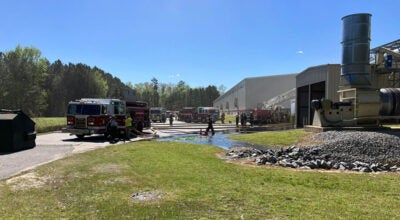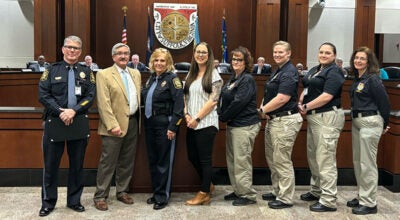College explores LPN program
Published 9:34 pm Monday, September 10, 2012

Candace Rogers, head of the Paul D. Camp Community College allied health program, shows college President Paul Conco how students learn on simulators, like “Kavin Hobbs,” pictured. The college is moving to establish an LPN nursing program to fill the void left by the closure of Suffolk Public Schools Sentara Obici Hospital School of Practical Nursing.
Paul D. Camp Community College hopes to open a school of practical nursing at its Suffolk and Franklin campuses by fall of 2013, the head of the college’s allied health program says.
“We expect we would be able to graduate a class of at least 30 students,” Candace Rogers said Monday at the Franklin campus. “It would be in Suffolk, and we’re looking at this campus as well.”
LPN students would attend one campus or the other, not commute between the two, Rogers added.
Rogers served on a committee formed in May to find new donors for the Sentara Obici Hospital School of Practical Nursing, operated under the jurisdiction of Suffolk Public Schools.
Formed in 1959, that school will graduate its final class in February 2013, after funding was cut from the school district’s budget; the committee was unable to find the estimated $350,000 to $400,000 to keep it running another year.
Paul D. Camp started its nursing school in 2004. It offers three registered nurse bridge programs and four allied health programs, ranging in duration from one evening and one day for the CPR course to five semesters over two years for the generic and certified-nursing-assistant-to-registered-nurse programs.
The college has received $129,000 from the Hampton Roads Community Foundation to begin planning an LPN program. “Some other interest from those who want to support the program” has also surfaced, PDCCC President Paul Conco said.
Conco could not yet confirm that the program will definitely be added, but he said, “We’re getting closer … everything seems to be heading on the right path.”
Introducing the program is “quite a process,” he explained, including defining a curriculum and gaining approval from the local College Board, the State Board for Community Colleges, the Southern Association of Colleges and Schools, and the Virginia Board of Nursing.
“The process will start with a letter of intent to the Virginia Board of Nursing, then go through everything … to getting the curriculum set,” he said. “We have to dot all the I’s and cross all the T’s, and we want to be good stewards in doing that.”
While the Suffolk school district’s LPN program is certain to be shuttered, the Southampton Memorial Hospital School of Practical Nursing, which receives funding from Southampton County Schools, is also facing a tough financial situation, according to Conco.
“Southampton Public Schools has said it’s not sure it can continue to support that program,” he said. The county school district had not responded by deadline to confirm or elaborate on Conco’s statement.
The cost of the LPN program at Paul D. Camp would depend on credit hours, Rogers said, with nursing students currently paying $4,500 for 36 hours.
Students would have two days of lectures a week, lasting “a couple of hours,” and two days a week in a hospital setting.
“We use all the area hospitals and community services,” Rogers said, adding the average LPN salary is $40,000.
Conco estimated an LPN program would take a quarter-million-dollar investment during the next two or three years. “We fully plan to keep it upgraded and cutting-edge,” he said.
The college uses patient simulators in its nursing school — Rogers said that one, the SimMom, simulates childbirth.
“They are sort of like robots that bleed,” Conco said. “They have bodily fluids, they have strokes and heart attacks, diabetic reactions, thinks like that.”





